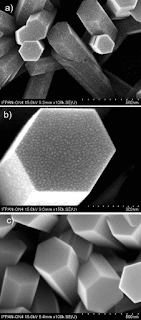 |
| FIG. 1. (a) Morphology of the NRs with 5–10 nm Ag nanoparticles. (b) Magnified image of 1(a). One NR with 5–10 nm Ag nanoparticles. (c) SEM image of the reference sample without Ag nanoparticles. Citation: J. Appl. Phys. 117, 193101 (2015); http://dx.doi.org/10.1063/1.4921424 |
Topics: (100), Nanoparticle, Nanorod, P-Type Silicon Substrate, Photoluminescence, Photovoltaic, Raman Spectroscopy, Wurzite
Abstract:
The test structures for photovoltaic (PV) applications based on zinc oxide nanorods (NRs) that were grown using a low-temperature hydrothermal method on p-type silicon substrates (100) covered with Ag nanoparticles (NPs) were studied. The NPs of three different diameters, i.e., 5–10 nm, 20-30 nm, and 50–60 nm, were deposited using a sputtering method. The morphology and crystallinity of the structures were confirmed by scanning electron microscopy and Raman spectroscopy. It was found that the nanorods have a hexagonal wurtzite structure. An analysis of the Raman and photoluminescence spectra permitted the identification of the surface modes at 476 cm−1 and 561 cm−1. The presence of these modes is evidence of nanorods oriented along the wurtzite c-axis. The NRs with Ag NPs were covered with a ZnO:Al (AZO) layer that was grown using the low-temperature atomic layer deposition technique. The AZO layer served as a transparent ohmic contact to the ZnO nanorods. The applicability of the AZO layer for this purpose and the influence of the Ag nanoparticles on the effectiveness of light acquisition by such prepared PV cells were checked by reflectance and transmittance measurements of the AZO/glass and AZO/NPs/glass reference structures. Based on these studies, the high-energy transmittance edge was assigned to the ZnO energy gap, although it is blueshifted with respect to the bulk ZnO energy gap because of Al doping. It was also shown that the most optimal PV performance is obtained from a structure containing Ag nanoparticles with a diameter of 20–30 nm. This result is confirmed by the current-voltage measurements performed with 1-sun illumination. The structures show a plasmonic effect within the short wavelength range: the PV response for the structure with Ag nanoparticles is twice that of the structure without the nanoparticles. However, the influence of the Ag nanoparticle diameters on the plasmonic effect is ambiguous.
American Institute of Physics:
Si/ZnO nanorods/Ag/AZO structures as promising photovoltaic plasmonic
E. Placzek-Popko1,a), K. Gwozdz1, Z. Gumienny1, E. Zielony1, R. Pietruszka2, B. S. Witkowski2, Ł. Wachnicki2, S. Gieraltowska2, M. Godlewski2,3, W. Jacak1 and Liann-Be Chang4
Comments